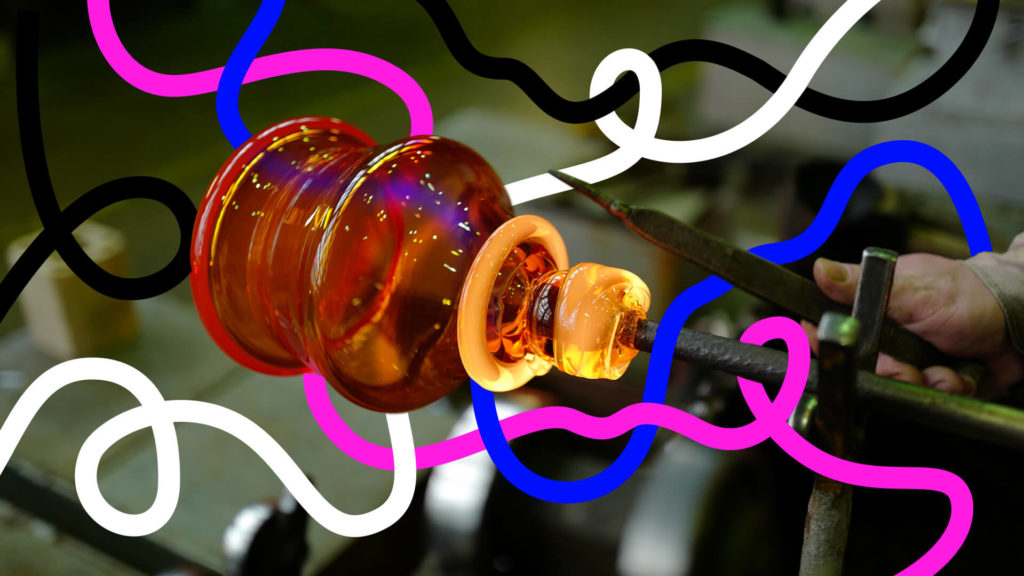1. Roman Švec, moulding expert
Beech and pear tree. Those two kinds of wood are the most common for the creation of glass moulds. In the Moser mould-making workshop – right under Roman’s hands – the journey of glass treasures begins. And it’s a difficult one. When being blown into moulds, the glass is hot, it gradually burns its way through the wood and the workers have no time to waste. They must keep producing new and new moulds, as the old ones get quickly damaged by the burning hot glass. “We must keep checking if the mould copies the given template. Otherwise, the final product wouldn’t have the fixed measurements. And we cannot afford to make even the slightest mistake,” Roman relates.
2. Tono Stano, designer
What symbolic value may the glass hold? That’s what we asked Tono Stano, a photographer and author of the KVIFF prize. While designing this celebrated statuette, Tono was thinking of what such a prize would mean for the winner – in association with the employed material. “Filmmakers wish to take hold of something – something huge, partly abstract. That’s what the crystal globe symbolizes. Though glass itself means a heavy substance, it seems rather light. Moreover, the crystal sphere optically rotates the image – together with the whole world. The female figure embraces and holds the world, while the world enhances the female in exchange. Owing to this, the prize aims to evoke the feeling of delight and euphoria,” Tono describes the intention and perception of glass as a material.
3. Martin Prokeš, technologist
New processes in technology and production, constant endeavour to increase the level of effectivity and quality. That’s what Martin Prokeš’s concern within Moser resides in. His job also includes the need to clarify and disprove myths. For example, Martin often says that despite its flexibility, glass as a material only has limited abilities. “People often think that you may create anything you wish from glass, claiming it is very easy to work with such a material. That’s a huge mistake. Glass as a material can be, in fact, rather limiting. It hardens unbelievably fast, so once you work with it, there is no time for hesitation,” Martin explains.
4. Mária Šmihulová, technologist
Moser glass is celebrated for its colours, inspired by precious stones. Formulas for the shades of elder, aquamarine or topaz are cautiously guarded by Mária. She is a qualified chemist, responsible for the preparation of the homogeneous blend – also known as a batch – with the right ratio of pigments and other substances, such as metal oxides. Absolutely precise work is required here, as the final shade cannot deviate from Moser’s spectrum of colours. And what is the biggest challenge? “Colouring with gold. Since it is a solid metal, you first need to adjust it in order to actually colour glass. As for the precise process, we will keep that a secret,” Mária laughs.
5. Zdeněk Drobný, glassmaker
Finally, glass is the subject of constant improvement, peak focus and endless interest. Zdeněk Drobný devoted his whole life to the craft, as he has been working in the glass factory for 50 years. And he still keeps thinking of how to enhance his work. “During my free time, I work on designs, contemplate, and imagine how the master glassmakers would proceed with it,” Zdeněk relates. According to him, working with glass is not only about ongoing experimentation, but also about patience and persistence. With the blowing iron, he often holds tens of kilograms of the glowing substance. He now shares his rich experience with the following generations, as he ought to retire during the next year. “But I’m willing to keep in close touch with glassmaking. I might even be helping in Moser. Glass is my whole life,” he says.
6. Maria Makeeva, illustrator
Embodiment of mythical themes and legacies. For Maria Makeeva, crystal represents a significant dose of inspiration. “Glass fascinates me. It’s almost hypnotic and filled with contradictions – physical, yet clear and pure. Firm and heavy, yet very fragile. It comes from the earth, but flames make its form become water-like. It reminds me of alchemy – as if there was a touch of magic within the art of glass,” she describes. Maria designed several artistic motifs for the MyMoser configurator. The golden phoenix may now spread its wings across the crystal background and send a message of hope to everyone drinking from the glass.





